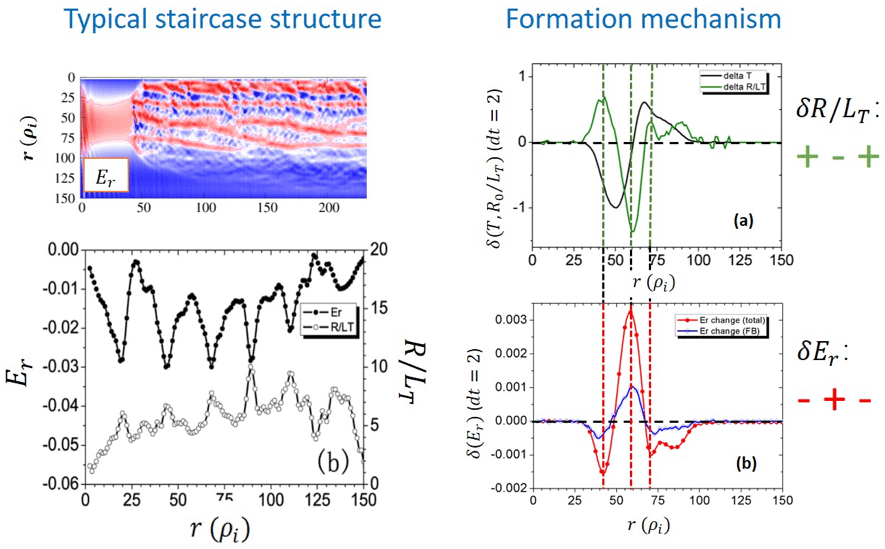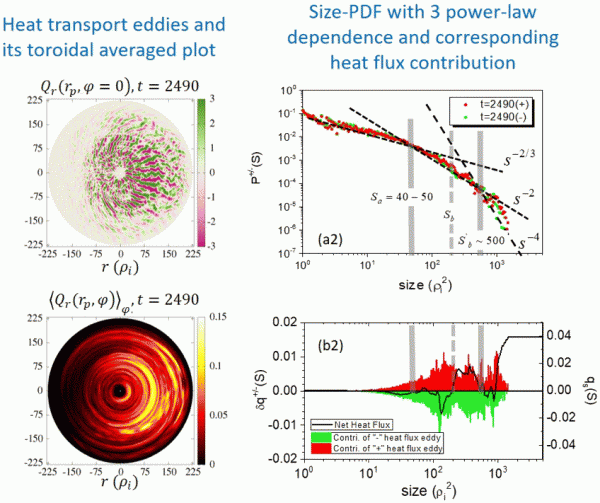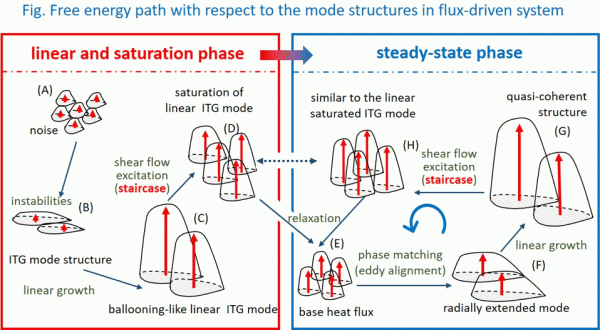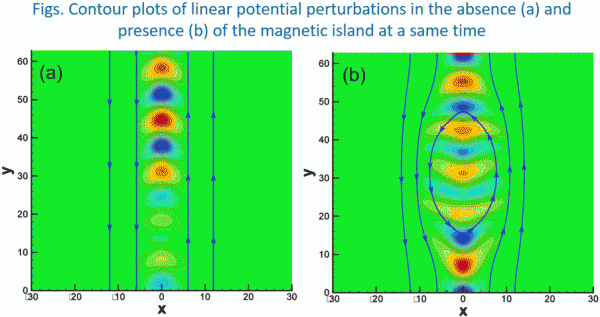プラズマ理論シミュレーショングループ
氏名:王 ウェイ
職制:研究員
住所:039-3212 青森県上北郡六ヶ所村大字尾駮字表舘2-166
Research Title
- E×B staircase in flux-driven gyro-kinetic simulation.
- Real-space statistical analysis (PDF) of turbulence transport.
- Magnetic-island-induced ion temperature gradient (MITG) instability.
- Shaping effect of ITG/TEM instabilities through full-f gyrokinetic simulation.
E×B staircase in flux-driven gyro-kinetic simulation.
Abstract
The mechanism for the formation and sustainment of a self-organized global profile and the “E×B staircase” are investigated through simulations of a flux-driven ion temperature gradient (ITG) turbulence based on GKNET, a five-dimensional global gyrokinetic code. The staircase is found to be initiated from the radially extended ITG mode structures with nearly up-down symmetry during the saturation phase, and is established as it evolves into a quasi-steady turbulence, leading to a self-organized global temperature profile and to meso-scale isomorphic profiles of the radial electric field and the temperature gradient. It is found that the quasi-regular E×B shear flow pattern is primarily originated from an even-symmetrical zonal flow produced by the extended ITG mode, which flow pattern exhibits an in-phase relation with the mean flow variation induced by the temperature relaxation. Consequently, the staircase is initiated through the profiles of total electric field and temperature gradient with a self-organized manner. Since the sign of E×B shear flow at the central part are opposite to that at both edges, it disintegrates the ITG mode into smaller scale eddies. Meanwhile, smaller scale eddies tend to be aligned radially by spontaneous phase matching, which can provide the growth of mode amplitude and the formation of radially extended mode structures, leading to the bursty heat transport. This process is repeated quasi-periodically, sustaining self-organized structures and the E×B staircase. Moreover, the equilibrium mean field is found to be of specific importance in causing the structures and dynamics from meso- to macro scales in toroidal plasmas.

Reference
[1] “A mechanism for the formation and sustainment of the self-organized global profile and E x B staircase in tokamak plasmas” Wang W., et al. NUCLEAR FUSION 58(5), 2018
[2] W.Wang, et al., JPS, Kanazawa Japan, 14aKA-1, 2016 (oral)
Real-space statistical analysis (PDF) of turbulence transport.
Abstract
Flux-driven ion temperature gradient (ITG) turbulence and associated transport regulated by non-local and non-diffusive processes in a global toroidal geometry are investigated based on GKNET simulations. Among these processes, instantaneous formation of the radially extended quasi-coherent turbulence which leads to the transport burst is found to play an important role on causing relaxation and associated global profile formation. To elucidate the characteristics of such a prominent transport process, we introduce the size probability distribution function (PDF) for heat flux eddies in the real space , with the eddy size, and incorporated with Fourier approaches in spectral space. In the quiescent phase which provides a base heat flux, the size PDF is found to be fitted by three piecewise power laws which transitions at two typical sizes Sa and Sb : P ∝ S-2/3 (S ≤ Sa), P ∝ S-2 (Sa ≤ S ≤ Sb), and P ∝ S-4 (S ≥ Sb), where Sa ~ 50 and Sb ~ 200 in squared gyro-radius unit ρi2 for the system with a/ρi ~ 225 (a : the minor radius). On the other hand, the PDF in the bursting phase exhibits a different power law in the region S > Sb . In particularly, it shows a non-power law irregular hump in the region S ≥ 500 which corresponds to the quasi-coherent structure that reaches S ~ 103. Such large scale quasi-coherent structures are ascribed to a probabilistic process that instantaneous phase matching between smaller scale eddies in radial direction, and subsequent growth to a large amplitude, causing large heat flux and then the relaxation on the profile. However, the net heat flux in both cases are found to be caused by the eddies in the region S > Sb. The distribution of heat flux intensity/density approximately fulfilled with quasi-linear mixing length estimate, which indicates that the linear instability also plays a role in quasi-steady state. Finally, transport is found to be regulated by the mixture between quasi-deterministic and probabilistic processes including SOC type avalanches, which leads to stiffness and resilience in the profile formation and self-similarity in the relaxation.


Reference
[1] “Statistical study for turbulent transport in flux-driven tokamak plasmas based on global gyro-kinetic simulation” Wang W., et al. NUCLEAR FUSION (under review)
[2] Y. Kishimoto, W.Wang, et al., IAEA-FEC, Kyoto Japan, TH/P3-2, 2016 (poster)
[3] W.Wang, et al., AAPPS-DPP, Kanazawa Japan, MF-O12, 2018 (oral)
Magnetic-island-induced ion temperature gradient (MITG) instability.
Abstract
Characteristics of magnetic-island-induced ion temperature gradient (MITG) mode are studied numerically by using a gyrofluid model in slab geometry, with the focus on the effects of Landau damping, equilibrium magnetic shear (EMS), and pressure flattening. It is shown that the magnetic island may enhance the Landau damping of the system by inducing the radial magnetic field. Moreover, the radial eigenmode numbers of most MITG poloidal harmonics are increased by the magnetic island so that the MITG mode is destabilized in the low EMS regime. In addition, the pressure profile flattening effect inside the magnetic island hardly affects the growth of the whole MITG mode, while it has different effects locally near the O-point and the X-point regions. In comparison with the non-zero-order perturbations, only the quasi-linear flattening effect due to the zonal pressure is the effective component to impact the growth rate of the mode.

Reference
[1] “Magnetic-island-induced ion temperature gradient mode: Landau damping, equilibrium magnetic shear and pressure flattening effects” W.Wang, et al., PLASMA SCIENCE & TECHNOLOGY 20(7), 2018
[2] W.Wang, et al., CMFTS, Beijing China, 2017 (poster)
Shaping effect of ITG/TEM instabilities through full-f gyrokinetic simulation.
Abstract
In Tokamak plasmas, the modification of magnetic shaping can cause significant influence on both magnetohydrodynamic (MHD) and drift-wave instabilities, and thus affects the confinement performance to a large extent. For instance, the effect of elongation has been proved to increase the global energy confinement time as seen in the ITER IPB98(y, 2) H-mode confinement scaling: τE ∝ κ0.78. In the past decades, people found that the D-shaped plasma can give a much better core confinement, which has a high edge pressure limit and is consistent with the reduced edge transport by the H-mode operation. Due to this advantage, such a magnetic shaping is utilized in most present and being constructed Tokamaks including ITER. On the other hand, a negative triangularity shape which exhibits better confinement even under the L-mode has been frequently discussed recently. Characteristics of plasma instabilities in such a geometry have been widely studied numerically and experimentally [1~3]. Since this shaping can have larger power handling area at the low-field side, it is considered to be a possible scenario of Tokamak reactor. However, lacking of theoretical analysis and global full-f simulation, its effect on turbulent transport in the toroidal system due to multi-scale ion temperature gradient (ITG) and trapped electron mode (TEM) instabilities is still not fully understood.
In this work, the effect of plasma shaping on linear ITG/TEM instabilities is studied based on the full-f GKNET (Gyro-Kinetic Numerical Experimental Tokamak) code. Utilizing the fixed boundary equilibrium code, elongations and triangularity (positive and negative) are scanned to study their influence on ITG/TEM instabilities and corresponding heat transport. At first, linear growth rate and corresponding mode structures are discussed based on the parameter scan. Then, dynamics of linear TEM instability is studied in the negative triangularity shaped plasma. It is found that the tilting of eigenmode structure may be responsible for the reduction of turbulent transport. This work can greatly help us to understand underlying physics of confinement performance change in the shaped plasmas.
Reference : None (being Progressed)

